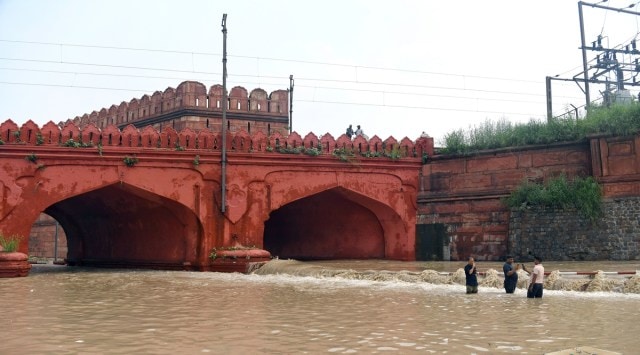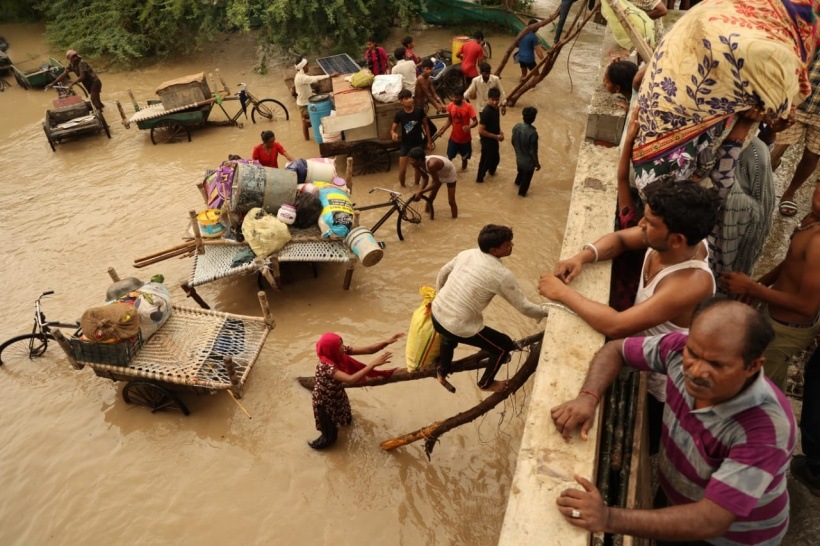Yamuna hits record high, set to recede — slowly
Red fort to raj ghat, isbt to civil lines, large parts of Delhi submerged
 Thursday afternoon, water from the overflowing Yamuna inundates Ring Road at Red Fort. ANI
Thursday afternoon, water from the overflowing Yamuna inundates Ring Road at Red Fort. ANI After touching 208.66 metres at 6 pm on Thursday, over a metre more than the previous record of 207.49 metres reported in 1978, the water level of the Yamuna is set to recede marginally by early Friday morning, after submerging the floodplains and leaving a few roads and low-lying areas of the national capital inundated.
The water level remained constant at 208.66 metres at 7 pm as well.
According to the Central Water Commission (CWC) forecast, marginal improvement is expected by 3 am on Friday with the levels expected to fall to 208.45 metres at the Old Railway Bridge. This would still be well above the river’s “danger” mark of 205.33 metres.
Several areas in the city, including Red Fort, Kashmere Gate, Civil Lines, Rajghat and ITO were inundated. The Archaeological Survey of India (ASI), which manages Red Fort, has shut the 17th century monument to visitors on Friday.
 Residents were seen wading through knee-deep water at Yamuna Bank near Old Iron Bridge. (Express Photo by Saman Husain)
Residents were seen wading through knee-deep water at Yamuna Bank near Old Iron Bridge. (Express Photo by Saman Husain)
An official of the Irrigation and Flood Control Department in Delhi said the peak discharge from the Hathnikund barrage in Haryana on Thursday was about 1.50 lakh cusecs. This is well below the peak discharge of 3.59 lakh cusecs released from Hathnikund on Tuesday. “The level is now more or less constant, and the forecast till Friday morning points towards a downward trend,” the official said.
On the water levels seen on Thursday, the official said: “If there was rainfall earlier between Hathnikund and Delhi, it can be difficult to tell if the water level downstream is rising on account of the release of 3.59 lakh cusecs from Hathnikund, or rainfall, or both. If water is released in dry weather, considering the run-off, around 60% to 80% of the released water reaches Delhi in about 36 to 40 hours. In the rainy season, the released water reaches Delhi with the flow of the river in about 36 hours”. The normal discharge from Hathnikund is around 352 cusecs.
Officials in the Haryana irrigation department said the water level at the Hathnikund barrage has seen a sharp decline.
The water from the barrage normally takes 72 hours to reach Delhi but officials believe it may have reached early this time because of the high water volume in the river. According to officials, the decrease in rainfall in the hills is the main reason behind the reduction in water level in the river at Hathnikund barrage.
“Now, we have started releasing water from Hathnikund barrage to our canals too. Only 60,000 cusecs of water is being released in the Yamuna river, which is normal discharge. This is even less than 70,0000 cusecs, which is known as low-flood level,” said a Haryana official.
The Army was deployed in Tapu Kamalpur village of Yamuna Nagar on Thursday, officials said.
The India Meteorological Department (IMD) forecast issued on Thursday evening said that isolated heavy rainfall is likely over Himachal Pradesh in the next five days, and over north Haryana in the next three days. Isolated very heavy to extremely heavy rainfall is also likely over Uttarakhand in the next five days. These are the three states through which the Yamuna passes before reaching Delhi, and heavy rainfall in the region has led to flooding in the city.
After heavy rainfall over the weekend in Delhi and other parts of northwest India, the Yamuna’s water level in Delhi crossed the “danger” mark of 205.33 metres on Monday evening, and has been rising since then.
In view of the situation, the Delhi Disaster Management Authority (DDMA) has announced a series of measures. It directed schools and colleges, and non-essential government offices to remain shut till Sunday. Only trucks carrying essential goods will be allowed into the city.
Inter-state buses from Haryana, Chandigarh, Himachal, Jammu and Kashmir, and Uttarakhand, which usually terminate at ISBT Kashmere Gate, will now terminate at the Singhu border. An advisory is also set to be issued to private offices, asking them to get their employees to work from home.
With the river’s water level breaching the 208-metre mark late on Wednesday night, parts of the Ring Road and areas abutting the river, including parts of Kashmere Gate, Civil Lines, the area near ITO, and some parts of East Delhi were inundated on Thursday.
Over 20,000 people who live along the floodplains of the river have moved to higher ground, either to temporary tents set up by the administration, or have set up their own makeshift tents on pavements along roads close to the floodplains.
Meanwhile, Lieutenant-Governor V K Saxena tweeted: “Prime Minister Narendra Modi called from France and inquired about the water-logging and flood situation in Delhi and the efforts being made to deal with it… He issued directions to take appropriate steps in the interest of Delhi by taking all possible help from the central government.”




























